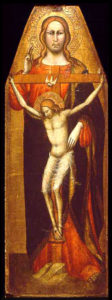Madonna and Child with Angels
Jacopo de Carolis
Below the image, click play to listen.
In this polyptych (or multi-paneled altarpiece) Gerini not only highlights the Madonna and Christ Child, but also explores the life of Mary Magdalene in his predella.
This is the only signed picture by this early Italian master. It also includes 55 faces!
Tempera on panel
Florentine, active 1392–1412

Lorenzo di Niccolò worked in Florence around the turn of the fifteenth century—one of the most significant centuries in history known as the Renaissance. Painting during this period continued in the tradition of Giotto (begun a century earlier), and Lorenzo’s own style was not much different from that tradition along with other contemporary artists. While paintings of the Trinity were common imagery within altarpieces of the time, Niccolò’s depiction is unique—painted in a way never done before. All known earlier representations of the Trinity in this configuration (known as “The Mercy Seat”) are depicted with God the Father sitting behind the crucified Christ; whereas, here, God the Father is shown standing.
Perhaps today this seems like an insignificant modification, but in the fourteenth century iconography was more codified; deviations articulated meaning, tradition, and Church dogma—all issues firmly upheld and monitored by Church officials. Interestingly, Trinity subjects with God the Father in a standing position were rare until the same concept appeared about 20 years later in one of the most famous paintings in history, Masaccio’s fresco of the Holy Trinity at Santa Maria Novella, Florence.
Another nuance of Niccolò’s imagery is that God the Father is also shown as a young man—the same likeness used for Christ. This approach heightens the physical and spiritual connection between the Father and Son, who are mysteriously distinct persons in a unified Trinity. However, the depiction of a youthful Heavenly Father was later forbidden by papal edict revealing that the iconography shown in this painting was short lived in art history.
An intriguing facet of this panel is that the entire back side of the panel is painted (with the exception of areas of wear and damage expected for an artwork over 600 years old). A full, decorative reverse side of a painting is somewhat common to early Italian panel paintings and suggests that people were intended to view the reverse. Sometimes entire narratives or portraits are found on the back of paintings; others have painted inscriptions or symbols for organizations such as confraternities. However, the pattern and application here supply a completely abstract, decorative function. In fact, the effect was intended to mimic the type of decorative marble inlaid patterns commonly incorporated into many existing Florentine churches, including the Duomo, Santa Maria Novella, and Santa Croce.
Preliminary research has revealed an almost identical pattern for what we see on this panel on a wall fresco border painted by Agnolo Gaddi in 1380 at Santa Croce. This pattern could be a clue to its inclusion in that same church to match the existing faux stonework existing on the walls. The pattern is distinct and would have the same markings as some or all of the other panels associated with the altarpiece from which this panel came. Such unique features can aid in attribution and dating, if related panels have firm documentation.
John M. Nolan, Curator
Published in 2014